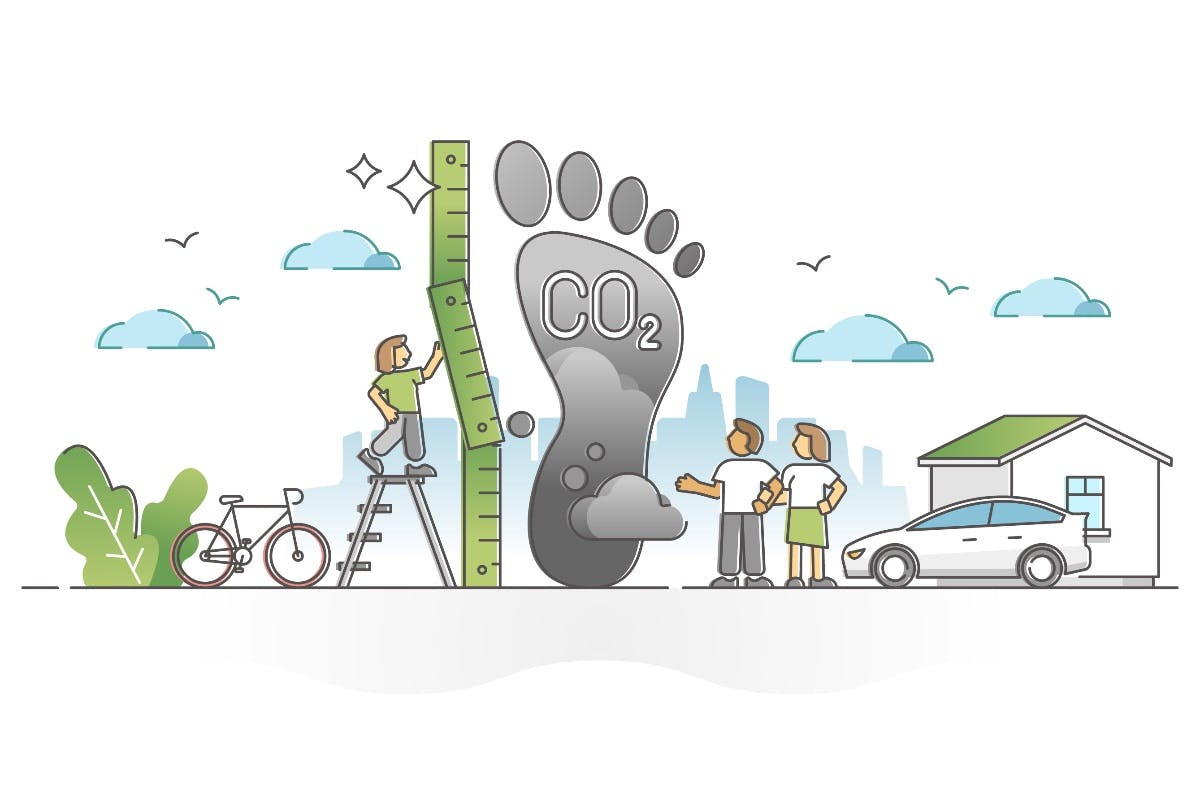What is a Carbon Footprint?
Last edited

Author
Andrew Blok
Electrification and Solar Writer and Editor

Editor
Ryan Barnett
SVP, Policy & New Market Development

When facing down the massive challenge of climate change, it makes sense to hold onto something tangible and manageable. For many, that thing is the carbon footprint.
A carbon footprint is the amount of carbon emissions generated by an activity, item, person, country, or anything else. Paying attention to carbon footprints can be helpful in deciding which of two options contributes less to global warming: An electric vehicle will have less of a climate impact than an internal combustion one, after manufacture and use, for example. But critics say carbon footprints are distracting from the real, systemic issues.
Here's what you need to know about carbon footprints.
See how much you can save with home energy changes
Definition of a Carbon Footprint
Carbon footprint is a term that represents the amount of carbon dioxide (CO2) and methane (CH4) released into the atmosphere as a result of the activities and choices of a person, group, or business. Those actions include the processes used to make the goods and services people use, since they often create greenhouse gases. When more greenhouse gases enter Earth’s atmosphere, more heat from the sun gets trapped in the atmosphere, and that trapped heat leads to climate change.
Just that shows that your carbon footprint is influenced by your individual choices but also things beyond your control, like supply chains and the choices of businesses. Most people can’t realistically eliminate their carbon footprint in today’s world. The more interconnected the situation, the more complex the potential solution, which means the average person often feels like they can’t make a difference.
When it comes to understanding carbon footprints, we focus on three key areas:
Personal footprint: Your individual contribution towards carbon emissions.
Corporate footprint: The impact of business activities on the environment. Companies can shrink their footprint by setting goals and reduction targets, as well re-tooling production processes to be more environmentally friendly.
National footprint: The impact of governmental activities on global warming, climate change, and pollution. Countries’ carbon footprints are affected by their policies on greenhouse gas emissions, power plant operations, and subsidies offered to companies involved in carbon-intensive activities like coal mining and oil drilling.
History of the Term Carbon Footprint
Early in the 21st century, the public began asking multinational companies to limit activities that harmed the planet. As a way of shifting focus away from their own activities, the fossil fuel industry responded by pushing the idea of individual responsibility.
The term “carbon footprint” was popularized by BP (one of the world's seven oil and gas "supermajors") with a $250 million advertising campaign, placing greater attention on personal choices and actions in terms of taking care of the planet, while shifting focus away from those large multinational companies and their impact on global warming.
The Roots of Your Personal Carbon Footprint
The primary contributors to climate change at a global level are fossil fuels. Burning coal, oil, and gas releases CO2 into the atmosphere. While fossil fuel companies and governments play a bigger role in contributing to and managing global emissions, it’s also important to understand the personal impact you have on the environment.
Here are some of the day-to-day activities you might do that contribute to greenhouse gas emissions and your personal carbon footprint.
Driving and flying
Cars and planes are the most common means of transport, and even though fuel economy has improved over time, they still generate a lot of carbon dioxide emissions. As vehicles and planes burn fuel, they emit greenhouse gases.
In comparison, cars and planes have a greater carbon footprint than other forms of mass transit, such as rail or bus. Cars and light trucks accounted for 16% of US greenhouse gases in 2022, according to a University of Michigan factsheet. Trains and buses also contribute to emissions, but it's not as much per passenger as personal vehicles and planes.
Energy use
Another factor in a personal carbon footprint is energy usage at home. A significant proportion of CO2 emissions produced by an average United States household come from using electricity and gas to heat water, keep lights on, and operate appliances. In 2020, more than half of energy use in American homes went to air conditioning and heating, according to the US Energy Information Administration. Another 19% went to water heating, 5% to lighting, and 3% to refrigeration.
Residential energy use accounted for more than 9% of carbon emissions in the US in 2022, according to the University of Michigan.

Credit: EIA
Water use
Since water heating can use so much energy, its use has an effect on your carbon footprint.
Waste management
Generating trash impacts your carbon footprint because the trash services use energy and natural resources such as water, timber, and fuel to process that waste. If they don’t operate efficiently, it can translate to significant greenhouse gas emissions.
Likewise, as some waste breaks down in a landfill, it releases greenhouse gases, especially methane.
Food
Another key contributor to your carbon footprint is the food you consume. If you are like many people, you purchase most of your food from grocery stores that partner with large-scale farms. In order to increase production quantity and standardize quality, many of these farms use synthetic fertilizers like ammonium nitrate.
Such fertilizers contribute to climate change in two key ways. First, their production requires a lot of energy. Secondly, some of these fertilizers undergo a chemical reaction after application that can lead to the production of nitrous oxide (N2O), a greenhouse gas. Nitrous oxide has a potent effect on climate.
Another way the food you consume contributes to greenhouse emissions is through transport. For food items to be available to you at your local store or supermarket, they often undergo several long-distance journeys by plane, cargo ship, and truck. This is especially true for uncommon and non-perishable food items.
Before they get to your dinner table, they may arrive in the country by sea or air. From there, depending on where you live, it may need to be transported by road to the wholesaler, and then transported again to your retailer. The carbon emissions for products increase significantly with each long journey they take. Eating local food can go a long way towards reducing those emissions.

Credit: United Nations
Additionally, the animal products you consume, especially red meat and dairy, are a key factor to greenhouse gas emissions. The high rates of production required to meet consumer demand is energy-intensive and results in a lot of carbon emissions. Because of this, a plant based diet typically has a lower carbon footprint.
How To Calculate Your Carbon Footprint
If you’re wondering how to calculate your personal carbon footprint, many nonprofits and governments have a carbon footprint calculator you can use.
- Environmental Protection Agency Carbon Footprint Calculator: Estimates your carbon footprint in three areas: home energy, transportation, and waste.
- Greenhouse Gas Equivalencies Calculator: Offers several units to choose from, allowing you to calculate your carbon footprint from multiple energy sources.
- Flight Carbon Footprint Calculator: Allows you to calculate your carbon emissions per flight. For more accurate results, you can even choose the class of flight.
See how much you can save with home energy changes
Key Factors in Calculating Your Carbon Footprint
Several considerations impact your carbon footprint, and you should account for them when you calculate your carbon footprint:
Size of your home
Generally, a bigger house will have more energy, water consumption, and waste management considerations. This typically translates to a higher carbon footprint.
Number of household members
This may seem obvious, but more people typically require more electricity, water heating, and waste management resources. The more people in your home–even in a small home–the more greenhouse gas emissions are likely generated from your daily activities.
However, the more people in your home might make your per person carbon emissions fall, just like carpooling.
Country
The country you live in also has a significant bearing on calculating your personal carbon emissions. Some countries still rely heavily on fossil fuels for their energy resources, while others use more renewable energy sources like solar, wind, and geothermal.
As a result, the average carbon footprint by country can vary quite a bit, depending on where you live. For example, the average American carbon footprint is 16 tons, compared to a global average of closer to 4 tons.

Credit: Our World in Data
Your daily activities
A carbon footprint calculator will typically ask you about some of the actions and energy use activities you participate in that can impact the environment.
- The number of cars you drive
- The type of car (electric, hybrid, or gas-powered)
- Whether you use public transportation
- The number of miles you drive each day
- The frequency of your flights
- The number of miles you fly
- The types of foods you eat and how often they are prepared at home vs ordered at a restaurant
- The types of appliances you use (dishwasher, washing machine, etc.)
- The types of electronics you use (computer, TV, etc.)
Keeping track of these items will help give you a clearer idea of your footprint.
Why You Should Reduce Your Carbon Footprint
Climate change is real, and it's happening right now. So, if you're looking to do something good for people and the planet, reducing your carbon footprint is one place to start.
You can help the environment
Climate change is perhaps the biggest threat to much of the environment. A study by the nonprofit World Wildlife Fund indicates that we may lose 20-30% of species by 2050 if nothing is done. In addition, coastal ecosystems and communities may be damaged or lost due to rising sea levels. Climate change means more dangerous severe weather, heat waves, and wildfires.
You can save money
Specific actions that reduce your carbon footprint can also save you money. Start small by taking shorter showers and unplugging electronic devices when they're not in use and check out this list of smart home energy saving devices that save you money. These simple changes can have a positive impact on your bills and the environment.
Improving the energy efficiency of your home means buying less electricity from your utility.
While EVs are typically more expensive than gas fossil fuel powered vehicles, their total cost of ownership can be lower for many people.
You can improve your health
Climate friendly actions can benefit your health, too. Walking places instead of driving, has a smaller carbon footprint than driving. A climate friendly diet might be a healthier one, too. Swapping a gas stove for an electric induction one can improve the air quality in your home.
How To Reduce Your Carbon Footprint
The good news is that immediate impacts that reduce your carbon footprint don’t take as much time or effort as you might think. Even better, small changes can lead to big results over time. Here are some of the things you can do to start.
Go solar
Using less electricity generated from fossil fuels can make a significant difference in your carbon footprint. One of the easiest ways to do this is by installing solar panels on your roof. Manufacturing solar panels is responsible for some carbon emissions, but solar panels’ carbon footprint is much smaller than fossil fuels like gas, oil, and coal. You can generate your own electricity from sunlight, and reduce your home's energy costs in the process. (Get a free estimate of your savings here.)
Improve the energy efficiency of your home
Making your home more energy efficient is one of the easiest ways to lower your carbon footprint, as it means you’re literally using less energy. Home improvement experts recommend tasks such as:
- Adding an additional layer of insulation to your attic areas
- Adding spray foam insulation to your walls
- Replacing cracked weatherstripping around doors and windows
- Installing double-pane energy-efficient windows
- Insulating your water heater and lowering its temperature to 120 degrees Fahrenheit
Steps like that will help keep the conditioned air inside your home at the same temperature for longer, making it more comfortable. That will also help your heater and air conditioning system run less, lowering your carbon footprint and your energy bills.
Since homes in different regions might have different insulation needs, it's always a good idea to check with a professional to understand your options. They can help you find the best type of insulation for your home, and even install it if needed.
For more tips and tricks, check out 6 Tips For Saving Energy (And Money!) Every Month.
Buy energy-efficient appliances
Using energy-efficient appliances is one of the easiest ways to reduce your carbon footprint and save money on utility bills. It's always a good idea to look for the blue "Energy Star" symbol on products before making your purchase, as this means the appliance has been independently verified to be energy-efficient.
See what home electrification can do for you:
Raise awareness
Once you've taken care of your own home, it's time to look at the bigger picture, because addressing climate change will take more than just one person acting alone. Educate your family and friends about the impacts of climate change and how individual people can make a collective difference.
Does My Carbon Footprint Matter?
Examining your carbon footprint can help you identify ways in which you can reduce your contribution to climate change, but some climate advocates deemphasize carbon footprints. Why? They say it distracts from the large-scale, systemic changes that are needed to fully address climate change.
It’s certainly true that one person zeroing out their carbon footprint won’t outweigh the carbon emissions of oil companies, for example. Many issues won’t be solved without government or institutional support. But, a lot of individuals taking action where they can can make a difference. Personal transportation, food, and home energy use all represent significant sources of carbon emissions and are all things individuals can start to address right now. While everyone’s situation is unique, taking steps to reduce your personal carbon footprint can be a meaningful action.
Key Takeaways
A carbon footprint refers to the CO2 emissions created by people, businesses, governments, and organizations, and we are both collectively and individually responsible for those emissions.
Activities such as driving, using electricity generated from fossil fuels, flying, and buying food that travels a great distance all contribute to your footprint. Fortunately, there are specific actions you can take to reduce greenhouse gas emissions and help curb climate change.
Palmetto provides solar panel solutions that can help you tap into solar energy and reduce your utility bills. Get started today with a Free Savings Estimate, and help you reduce your carbon footprint with a solar panel system that suits your needs.
Frequently Asked Questions
Why is a carbon footprint important?
When it comes to the individual, a carbon footprint is the carbon emissions associated with your life, whether from your travel, diet, possessions, or home.
What are the biggest things I can do to lower my carbon footprint?
Some of the most significant ways you can decarbonize your life include driving an electric vehicle instead of a gas-powered one, going solar, making your home energy efficient, and electrifying it.
Is lowering my carbon footprint important?
Yes, especially if you have a particularly large one. Transportation and buildings account for large portions of the United States' carbon emissions. If you own a home or drive a car, those are good places to start.
What are the easiest things I can do to lower my carbon footprint?
Look for low hanging fruit, like swapping out old incandescent light bulbs for LED ones, experimenting with small changes to your diet, and unplugging appliances when they’re not in use.
Who popularized the carbon footprint?
Carbon footprints were popularized by oil companies. Obsessing over your carbon footprint can be distracting from larger climate issues that also need to be addressed.


